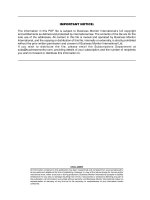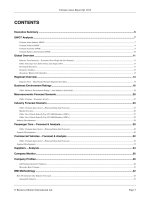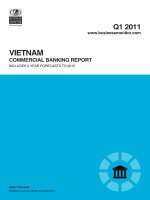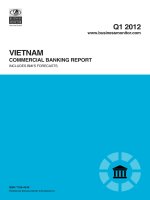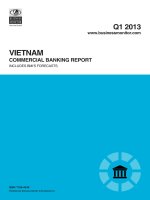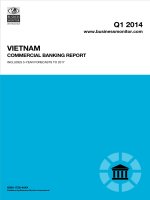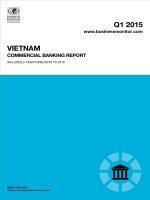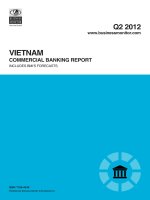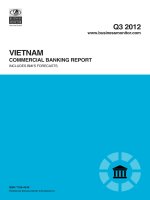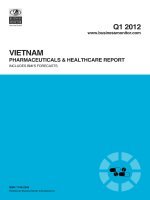Vietnam freight transport report q1 2012
Bạn đang xem bản rút gọn của tài liệu. Xem và tải ngay bản đầy đủ của tài liệu tại đây (521.36 KB, 47 trang )
Q1 2012
www.businessmonitor.com
VietnaM
freight transport Report
INCLUDES BMI'S FORECASTS
ISSN 1750-5364
Published by Business Monitor International Ltd.
VIETNAM
FREIGHT TRANSPORT
REPORT Q1 2012
INCLUDES 5-YEAR FORECASTS TO 2016
Part of BMI’s Industry Survey & Forecasts Series
Published by: Business Monitor International
Copy deadline: November 2011
Business Monitor International
85 Queen Victoria Street
London
EC4V 4AB
UK
Tel: +44 (0) 20 7248 0468
Fax: +44 (0) 20 7248 0467
email:
web:
© 2011 Business Monitor International.
All rights reserved.
All information contained in this publication is
copyrighted in the name of Business Monitor
International, and as such no part of this publication
may be reproduced, repackaged, redistributed, resold in
whole or in any part, or used in any form or by any
means graphic, electronic or mechanical, including
photocopying, recording, taping, or by information
storage or retrieval, or by any other means, without the
express written consent of the publisher.
DISCLAIMER
All information contained in this publication has been researched and compiled from sources believed to be accurate and reliable at the time of
publishing. However, in view of the natural scope for human and/or mechanical error, either at source or during production, Business Monitor
International accepts no liability whatsoever for any loss or damage resulting from errors, inaccuracies or omissions affecting any part of the
publication. All information is provided without warranty, and Business Monitor International makes no representation of warranty of any kind
as to the accuracy or completeness of any information hereto contained.
Vietnam Freight Transport Report Q1 2012
© Business Monitor International Ltd
Page 2
Vietnam Freight Transport Report Q1 2012
CONTENTS
Executive Summary ......................................................................................................................................... 5
SWOT Analysis ................................................................................................................................................. 7
Vietnam Freight Transport SWOT ......................................................................................................................................................................... 7
Vietnam Political SWOT ........................................................................................................................................................................................ 7
Vietnam Economic SWOT ...................................................................................................................................................................................... 8
Vietnam Business Environment SWOT................................................................................................................................................................... 9
Industry Trends And Developments ............................................................................................................ 10
Maritime .............................................................................................................................................................................................................. 10
Intermodal And Logistics ..................................................................................................................................................................................... 12
Market Overview ............................................................................................................................................. 14
Global Oil Products Price Outlook ............................................................................................................... 17
Industry Forecast ........................................................................................................................................... 20
Road Freight ........................................................................................................................................................................................................ 20
Table: Road Freight, 2008-2016.......................................................................................................................................................................... 20
Rail Freight ......................................................................................................................................................................................................... 20
Table: Rail Freight .............................................................................................................................................................................................. 20
Air Freight ........................................................................................................................................................................................................... 21
Table: Air Freight ................................................................................................................................................................................................ 21
Maritime And Inland Waterways ......................................................................................................................................................................... 21
Table: Maritime Freight - Throughput, 2008-2016 ('000 tonnes) ........................................................................................................................ 22
Table: Inland Waterway Freight .......................................................................................................................................................................... 22
Trade ................................................................................................................................................................................................................... 22
Table: Trade Overview ........................................................................................................................................................................................ 22
Table: Key Trade Indicators, 2008-2016 (US$mn and % change y-o-y) ............................................................................................................. 23
Table: Main Import Partners, 2002-2009 (US$MN)............................................................................................................................................ 24
Table: Main Export Partners, 2002-2009 (US$MN)............................................................................................................................................ 24
Political Outlook ............................................................................................................................................. 25
Foreign Policy ..................................................................................................................................................................................................... 25
Domestic Politics ................................................................................................................................................................................................. 27
Long-Term Political Outlook ............................................................................................................................................................................... 28
Macroeconomic Outlook ............................................................................................................................... 31
Table: Vietnam – Macroeconomic Activity, 2009-2015 ....................................................................................................................................... 32
Company Profiles ........................................................................................................................................... 34
Vietnam Airlines Cargo ....................................................................................................................................................................................... 34
Vinatrans ............................................................................................................................................................................................................. 36
Vietnam National Shipping Lines (Vinalines) ...................................................................................................................................................... 38
Vietnam Petroleum Transport Company (VIPCO)............................................................................................................................................... 40
Country Snapshot: Vietnam Demographic Data ......................................................................................... 41
Section 1: Population........................................................................................................................................................................................... 41
Table: Demographic Indicators, 2005-2030 ........................................................................................................................................................ 41
Table: Rural/Urban Breakdown, 2005-2030 ....................................................................................................................................................... 42
Section 2: Education And Healthcare .................................................................................................................................................................. 42
Table: Education, 2002-2005 .............................................................................................................................................................................. 42
Table: Vital Statistics, 2005-2030 ........................................................................................................................................................................ 42
Section 3: Labour Market And Spending Power .................................................................................................................................................. 43
© Business Monitor International Ltd
Page 3
Vietnam Freight Transport Report Q1 2012
Table: Employment Indicators, 1999-2004 .......................................................................................................................................................... 43
Table: Consumer Expenditure, 2000-2012 (US$) ................................................................................................................................................ 43
BMI Methodology ........................................................................................................................................... 44
How We Generate Our Industry Forecasts .......................................................................................................................................................... 44
Transport Industry ............................................................................................................................................................................................... 44
Sources ..................................................................................................................................................................................................................... 45
© Business Monitor International Ltd
Page 4
Vietnam Freight Transport Report Q1 2012
Executive Summary
Vietnam's freight transport sector is set to continue its steady growth trajectory over the medium term
with the spectre of overcapacity a looming threat on the horizon. The required pace of expansion
continues to pose a problem due to the state of infrastructure in the country and we caution that
investment is needed if Vietnam is to fulfil its potential.
In terms of year-on-year (y-o-y) tonnage growth, the Port of Ho Chi Minh City is set to lead the way in
2012, with a healthy increase of 7.96% forecast, while air, road and rail are all expected to perform
solidly in 2012 and to 2016.
There are some dark clouds hovering on the horizon, however. BMI believes that the recent rise in
Vietnamese sovereign credit default swaps suggests that investors are pricing in growing risks of a
sovereign debt default. We believe that deteriorating global economic headwinds and rising debt
servicing costs are among the key reasons behind growing pessimism over the government's credit
worthiness. Although the latest rate hike could put further downward pressure on growth and raise debt
servicing costs in the near term, we are positive that higher interest rates will help attract more foreign
capital into the country.
Headline Industry Data
2012 rail freight tonnage is set to increase by 5.29% to 8.62mn tonnes.
2012 air freight tonnage is forecast to rise by 5.72% to 206,960 tonnes.
Tonnage handled at the Port of Ho Chi Minh City in 2012 is forecast to grow 7.96% in 2012,
whereas tonnage handled at the Port of Da Nang is forecast to increase 3.08%.
2012 road freight tonnage is forecast to grow by 6.97%.
2012 total trade is forecast to rise by 7.25%
Key Industry Trends
Ho Chi Minh Faces Overcapacity And Infrastructure Concerns
Vietnam's port sector has seemingly become a victim of its own success as rapid growth has seen the
country's underdeveloped port sector struggle to keep pace with increasing volumes of trade. BMI
believes this pressure could ease somewhat in 2012 as global economic headwinds continue to act as a
dampener on external demand for Vietnamese exports.
Upgrade For Mekong Delta Ports Crucial To Economic Growth
The Vietnamese government announced major plans in September 2011 to boost the combined port
capacity in the Mekong Delta provinces from 15.7mn tonnes in 2010 to 28mn tonnes in 2020. BMI
© Business Monitor International Ltd
Page 5
Vietnam Freight Transport Report Q1 2012
welcomes such an investment, as we have long held the view that Vietnam's port sector requires
considerable investment if it is to handle a projected increase in trade, as mentioned above.
Kerry Logistics Invests In Vietnam
Hong Kong-based Kerry Logistics announced in September 2011 that it is set to open a new logistics
centre in Hanoi, Vietnam. The centre will be located on the road to the main port of Haiphong, providing
the company with excellent access to one of Vietnam's major logistics hubs. The 10,000 square metre
facility is expected to complete the company's plan to offer a high level of coverage for all the industrial
centres in Vietnam, reports Eye for Transport.
Key Risks To Outlook
On the upside, Vietnamese state-owned port operator Vietnam National Shipping Lines (Vinalines)
signed a contract in October 2011 with Japan-based Molyto (a joint venture between three Japanese
companies: Mitsui O.S.K. Lines, Nippon Yusen Kabushiki Kaisha and Itochu) to construct two berths
at the Lach Hyuen port in Northern Vietnam. BMI notes that it is mainly Japanese companies that are
developing Vietnam's northern deep sea ports.
We have long highlighted the importance of foreign investment in Vietnam's port infrastructure due to its
implications for the country's economic growth. While the southern port of Ho Chi Minh is facing the
prospect of overcapacity, there remains a significant demand for deep-water port capacity in the northern
parts of Vietnam.
This is because the country is looking to develop deep-water ports in key regions, allowing goods to be
shipped directly to their destination markets instead of transshipping through Singapore, Malaysia and
South Korea. The Lach Hyuen port is located just 100km east of Vietnam's capital Hanoi, and is expected
to eventually replace the nearby Hai Phong port - currently the largest port in the northern region of
Vietnam. The Hai Phong port is reaching capacity and does not have adequate infrastructure to handle
some of the larger container ships. The Lach Hyuen port expansion will be implemented to address this
deficit.
On the other hand, downside risks exist in Vietnam's port sector, due to the rapid growth in the country's
port volumes and subsequent concerns that have been raised over the possibility of overcapacity at the
Port of Ho Chi Minh. Additionally, there is some sense of déjà vu in the global infrastructure space.
Valuations are falling, credit is drying up, demand risk is rising and investors are avoiding risk; factors
seem to be aligning for a repeat of the fall of 2009. While we see several red flags in the infrastructure
finance market, we do not believe that the market will come to a standstill.
© Business Monitor International Ltd
Page 6
Vietnam Freight Transport Report Q1 2012
SWOT Analysis
Vietnam Freight Transport SWOT
Strengths
Weaknesses
Opportunities
Threats
Vietnam's strong domestic growth rate coupled with its geography: it stretches for
thousands of kilometres on a north-south axis, creating a need for long-distance
freight haulage.
Recovery of the nation's ports in 2010 is expected to continue over the mid-term to
2016.
Vietnam's location on the South China Sea gives the country access to the main interAsian shipping routes, as well as access to the developing land transport links with
ASEAN countries, allowing the country scope to develop its trade logistics.
The generally poor state of the road network. Despite new highway construction, only
13.5% of the network is considered to be in good condition. Just 26% of the network
has two or more lanes and only 29% is tarred.
Traditionally low investment in rail, with the potential for cost-effective bulk rail freight
being underutilised.
Decades of under-investment have left the country with a port infrastructure system
that is poor by international standards. Overcapacity is therefore a growing problem.
The beginnings of local commercial vehicle production, which will help improve the
stock of lorries used by road haulage companies.
Chinese investment could bring about much needed improvements in the rail sector.
Growing international interest in Vietnam as a growth market within the box shipping
sector.
Vietnam risks losing out to neighbouring countries if it is unable to develop its
infrastructure to keep up with the pace of demand.
Vietnam is vulnerable to any slowdown in Chinese investment.
A drop in international demand for exports would negatively affect Vietnam's freight
transport sector.
Vietnam Political SWOT
Strengths
Weaknesses
Opportunities
The Communist Party of Vietnam remains committed to market-oriented reforms and
we do not expect major shifts in policy direction over the next five years. The oneparty system is generally conducive to short-term political stability.
Relations with the US have witnessed a marked improvement, and Washington sees
Hanoi as a potential geopolitical ally in South East Asia.
Corruption among government officials poses a major threat to the legitimacy of the
ruling Communist Party.
There is increasing (albeit still limited) public dissatisfaction with the leadership's tight
control over political dissent.
The government recognises the threat corruption poses to its legitimacy, and has
acted to clamp down on graft among party officials.
Vietnam has allowed legislators to become more vocal in criticising government
policies. This is opening up opportunities for more checks and balances in the system.
© Business Monitor International Ltd
Page 7
Vietnam Freight Transport Report Q1 2012
Threats
Macroeconomic instabilities in 2010 and 2011 are likely to weigh on public acceptance
of the one-party system, and street demonstrations to protest economic conditions
could develop into a full-on challenge of undemocractic rule.
Although strong domestic control will ensure little change to Vietnam's political scene
in the next few years, over the longer term, the one-party-state will probably be
unsustainable.
Relations with China have deteriorated over recent years due to Beijing's more
assertive stance over disputed islands in the South China Sea and domestic criticism
of a large Chinese investment into a bauxite mining project in the central highlands,
which could potentially cause wide-scale environmental damage.
Vietnam Economic SWOT
Strengths
Weaknesses
Opportunities
Threats
Vietnam has been one of the fastest-growing economies in Asia in recent years, with
GDP growth averaging 7.2% annually between 2000 and 2010.
The economic boom has lifted many Vietnamese out of poverty, with the official
poverty rate in the country falling from 58% in 1993 to 12.0% in 2009.
Vietnam still suffers from substantial trade, current account and fiscal deficits, leaving
the economy vulnerable to global economic uncertainties in 2011. The fiscal deficit is
dominated by substantial spending on social subsidies that could be difficult to
withdraw.
The heavily-managed and weak dong currency reduces incentives to improve quality
of exports, and also keeps import costs high, contributing to inflationary pressures.
WTO membership has given Vietnam access to both foreign markets and capital,
while making Vietnamese enterprises stronger through increased competition.
The government will in spite of the current macroeconomic woes, continue to move
forward with market reforms, including privatisation of state-owned enterprises, and
liberalising the banking sector.
Urbanisation will continue to be a long-term growth driver. The UN forecasts the urban
population rising from 29% of the population to more than 50% by the early 2040s.
Inflation and deficit concerns have caused some investors to re-assess their hitherto
upbeat view of Vietnam. If the government focuses too much on stimulating growth
and fails to root out inflationary pressure, it risks prolonging macroeconomic instability,
which could lead to a potential crisis.
Prolonged macroeconomic instability could prompt the authorities to put reforms on
hold as they struggle to stabilise the economy.
© Business Monitor International Ltd
Page 8
Vietnam Freight Transport Report Q1 2012
Vietnam Business Environment SWOT
Strengths
Weaknesses
Opportunities
Threats
Vietnam has a large, skilled and low-cost workforce, that has made the country
attractive to foreign investors.
Vietnam's location - its proximity to China and South East Asia, and its good sea links
- makes it a good base for foreign companies to export to the rest of Asia, and
beyond.
Vietnam's infrastructure is still weak. Roads, railways and ports are inadequate to
cope with the country's economic growth and links with the outside world.
Vietnam remains one of the world's most corrupt countries. Its score in Transparency
International's 2010 Corruption Perceptions Index was 2.7, placing it in 22nd in the
Asia-Pacific region.
Vietnam is increasingly attracting investment from key Asian economies, such as
Japan, South Korea and Taiwan. This offers the possibility of the transfer of high-tech
skills and know-how.
Vietnam is pressing ahead with the privatisation of state-owned enterprises and the
liberalisation of the banking sector. This should offer foreign investors new entry
points.
Ongoing trade disputes with the US, and the general threat of American
protectionism, which will remain a concern.
Labour unrest remains a lingering threat. A failure by the authorities to boost skills
levels could leave Vietnam a second-rate economy for an indefinite period.
© Business Monitor International Ltd
Page 9
Vietnam Freight Transport Report Q1 2012
Industry Trends And Developments
Maritime
Ho Chi Minh Faces Overcapacity And Infrastructure Concerns
Short Term: Overcapacity Fears Present Downside Risk
Throughput at Vietnamese ports has grown dramatically in recent years as the country has sought to
position itself as 'the factory of Asia'. Rapid growth has seen the country's underdeveloped port sector
struggle to keep pace with increasing volumes of trade. BMI believes this pressure could ease somewhat
in 2012 as global economic headwinds continue to act as a dampener on external demand for Vietnamese
exports.
This presents downside risk for production activity in the manufacturing sector and other export-based
industries. While BMI forecasts real GDP growth of 6.5% in 2012 - up from an estimated 6% growth in
2011 - we expect year-on-year (y-o-y) growth in Ho Chi Ming Port's container throughput to slow to
5% in 2012 to 3.1mn twenty-foot equivalent units (TEUs), down from the double-digit growth we saw in
the years prior to 2011. We expect total tonnage growth of 8% at the port, to 36mn tonnes.
We caution that there are downside risks to our forecasts. The rapid growth in Vietnam's port volumes has
attracted ample international investment in port terminals, and concerns are now being raised about the
possibility of overcapacity at Ho Chi Minh. In 2006, international terminal operators secured stakes in
nine terminals at the port after the government invited foreign investment, believing that rising throughput
volumes would be quickly soaked up by increasing capacity.
Five of the nine planned terminals are currently in operation in the Cai Mep area. However, they are
working well below capacity, according to Alphaliner. With additional new facilities due to come online
within the next two years, BMI believes this is a considerable cause for concern.
The situation is causing particular concern for companies that have facilities due to come online in the
near future. SSIT, a joint venture (JV) between Saigon Port, SSA International Holdings-Vietnam and
Vinalines is due to open in 2011. The terminal will have a handling capacity of 1.2mn TEUs and the
ability to receive ships of up to 8,000TEUs. John Cushing, general director of international container
services at SSIT, said: 'Whenever we look at this much development - and it is unusual anywhere to see
so many new terminal operations being built in a region at the same time - it always brings up the
question: Are you building to overcapacity?'
Medium Term: Upside Potential From Dredging Project
Over the medium term we forecast average annual real GDP growth of 7.2% for Vietnam. In line with
this, we expect steady growth in the country's port throughput to continue, although not in the doubledigit figures seen previously. We forecast average annual growth of 8.3% in total tonnage to reach 49mn
tonnes by 2016, and average annual growth in container throughput of 6.6% to reach 4mn TEUs.
© Business Monitor International Ltd
Page 10
Vietnam Freight Transport Report Q1 2012
Upside potential to our forecasts is presented by the Vietnamese government's plans to deepen the port's
draught, allowing larger vessels to access the facility. Recognising the need to cater for bigger vessels,
Vietnam's prime minister has directed the country's ministry of transport and its Maritime Administration
to focus on developing deep water ports. A channel depth of about 14 metres (m) is required for non-tide
restricted access for vessels with capacity of up to 8,000TEUs.
Vietnam is to develop further deep water ports to allow the country to ship goods directly to destination
markets instead of transshipping through Singapore, Malaysia and South Korea. Priority will be given to
the Lach Huyen port complex in the northern city of Hai Phong, and to the Cai Mep and Ben Dinh port
complexes over the next five years.
Long Term: Infrastructure Improvements Needed
As previously stated, capacity at the port of Ho Chi Minh has expanded to the level that we are now
concerned about overcapacity at the facility. However, capacity expansion alone is not enough to equip
Ho Chi Minh to handle growing volumes of trade. We also need to see investment in landside supply
chains, such as road and rail networks. These developments are particularly vital if Vietnam is to achieve
its aim of enabling Ho Chi Minh to handle larger container vessels so that it can ship goods directly to
destination markets.
Upgrade For Mekong Delta Ports Crucial To Economic Growth
The Vietnamese government announced major plans in September 2011 to boost the combined port
capacity in the Mekong Delta provinces from 15.7mn tonnes in 2010 to 28mn tonnes in 2020. BMI
welcomes such an investment, as we have long held the view that Vietnam's port sector requires
considerable investment if it is to handle a projected increase in trade.
According to the government's proposals, the expansion in capacity would focus on river ports and
seaports located on the Tien and Hau rivers - the main tributaries of the Mekong River.
In the Tien River basin, the improvements will focus on: the Cao Lanh-Sa Dec port in Dong Thap
province, the My Tho port in the Tien Giang province, the Vinh Thai port in the Vinh Long province and
the Ham Luong port in the Ben Tre province.
In the Hau River basin, the upgrades will involve: the Cai Cui, Tra Noc and Can Tho ports in the city of
Can Tho; the My Thoi port in the An Giang province; the Dai Ngai port in the Soc Trang province; and
the Tra Cu port in the Tra Vinh province. The upgrades will enable these ports to accommodate vessels
with a capacity of 5,000 deadweight tonnes (DWT) or, in some ports, up to 10,000DWT.
Furthermore, new sea ports will be constructed in the Ca Mau peninsula and in the Gulf of Thailand.
They include the Nam Can seaport in the Ca Mau province as well as the Hon Chong, Bai No, and Binh
Tri ports in the Kien Giang province. These ports, once completed, will also be able to receive vessels
of between 5,000DWT and 10,000DWT.
© Business Monitor International Ltd
Page 11
Vietnam Freight Transport Report Q1 2012
We believe that this expansion in Vietnam's port capacity is crucial to the country's economic growth as
the transportation of freight through inland waterways accounts for a sizeable portion - 25-30% - of total
domestic cargo transport. Vietnam's waterway system is one of the largest in relation to its land area in
the world: according to data from the World Bank, Vietnam has around 41,000km of natural waterways.
Waterways are also crucial to Vietnam's export output, as they are an important means of transport for
heavy goods including: coal, rice, sand, stone and gravel. This is especially true for the Mekong delta
provinces, which is one of the leading rice growing regions in Vietnam and the world. A lack of adequate
port facilities in the region would definitely have a negative impact on Vietnam's agricultural exports, a
key component in the country's economy. As such we welcome the government's plan and have taken it
into account in our forecasts; real growth in the value of Vietnam's ports, harbours and waterways
infrastructure averages 8.3% per annum between 2011 and 2015.
Intra-Asia Road Route To Enhance Shippers' Operations
It was announced in August 2011 that southeast Asia is to be linked to China through a new intra-Asia
route built by Panalpina, in a bid to improve transit times for regional shippers. The countries
connected by the route would be Vietnam, Laos, Thailand, Malaysia and Singapore.
It is hoped that the new service will provide a better alternative to costly air freight or the much slower
ocean freight, as well as offering a more eco-friendly option to both of these modes. The new freight
solution will cater for full-truck-load (FTL) and less-than-truck-load (LTL) shipments.
Andreas Wolff, Panalpina's area trade lane development manager for intra-Asia, explained: 'The service
covers a number of major cities in western China such as Chengdu and Chongqing, where the entire
market still struggles to find adequate capacity for air and ocean transport. Our trucking solution will
come in very handy here.'
District Manager of the Yangtze and Bohai Bay at Panalpina, Stefan Gustafsson, said: 'All trucks are
equipped with GPS devices, and CCTV systems are installed inside each container to survey the cargo,
ensuring highest security standards. Considering that it is still a relatively fresh and new way for high-end
transportation, we will further tailor the service to the customer and market requirements.'
Intermodal And Logistics
Gemadept Predicts 2012 Rise In Fees
In September 2011, Vietnam's biggest listed freight company, Gemadept, predicted that local cargo rates
will rise as smaller firms drop out of the market. According to the Business Times, the firm expects rates
changes to begin affecting the industry from mid-2012, as rival companies who have lowered
their charges fail to survive. The issue is part of a wider malaise, as smaller firms struggle with higher
fuel costs, overcapacity and lower demands from the US and EU.
© Business Monitor International Ltd
Page 12
Vietnam Freight Transport Report Q1 2012
Kerry Logistics Invests In Vietnam
Hong Kong-based Kerry Logistics announced in September 2011 that it is set to open a new logistics
centre in Hanoi, Vietnam. The centre will be located on the road to the main port of Haiphong, providing
the company with excellent access to one of Vietnam's major logistics hubs. The 10,000 square metre
facility is expected to complete the company's plan to offer a high level of coverage for all the industrial
centres in Vietnam, reports Eye for Transport.
Robert Tan, managing director of the South Asia region at Kerry Logistics, said: 'We have invested in
developing a national logistics network in Vietnam during the last few years and the new Hanoi facility
completes our coverage of the key industrial areas in North, South and Central Vietnam.'
© Business Monitor International Ltd
Page 13
Vietnam Freight Transport Report Q1 2012
Market Overview
Slightly Slower Growth In 2011
We remain optimistic that we could see a pickup in GDP growth to reach 6.5% in 2012, after estimated
growth of 6% in 2011. Leading indicators suggest that economic activity should continue to moderate,
and we see this as a positive sign that government efforts to iron out the country's macroeconomic
imbalances remain on track. Prevailing economic headwinds in the US and Eurozone should continue to
act as a dampener on external demand. This in turn suggests that production activity in the manufacturing
sector and other export-based industries could face difficulties, with negative effects for the freight
transport industry.
Retail sales have moderated considerably since November 2010, when the State Bank of Vietnam (SBV)
initiated its monetary tightening cycle. Retail sales growth slowed from 32.5% in November 2010 to
22.6% in June 2011, indicating that the measures have dampened private consumption growth.
Nonetheless, retail sales remain at double-digit growth rates, indicating that private consumption growth
remains resilient. This supports our view that private consumption would remain resilient on the back of
robust labour market conditions and rising wages in Vietnam, boding well for containerised imports.
However, public spending cuts and a subdued outlook on gross fixed capital formation (GFCF)
growth due to high lending rates would lead to continued moderation in domestic demand throughout the
year.
Underperforming
Port And Road Infrastructure Rankings
Source: World Economic Forum
Road Freight Remains Dominant
Road transport is the most advanced in terms of freight sector privatisation and is the dominant mode for
© Business Monitor International Ltd
Page 14
Vietnam Freight Transport Report Q1 2012
freight, with a market share of around 60% of domestic cargo. Few foreign companies are present in the
market, and there are many small, family owned road freight companies operating informally.
Vietnam has a national road network of 171,392km. BMI believes the sector requires substantial
investment. The quality of Vietnam's road infrastructure was judged by the World Economic Forum
(WEF) to be very poor, ranking 123rd out of 142 nations surveyed in its Global Competitiveness Report
2011-2012.
Vietnam's railway transport sector has just one operator, the Vietnam Railway Corporation (VRC),
established in April 2003 as a state corporation operating railway transport and related services.
Vietnam's rail network totals 2,347km.The network is of mixed-gauge, comprising 2,169km of 1.000m
gauge and 178km of 1.435m gauge. Railway infrastructure in Vietnam was ranked 101 out of 123 by the
WEF.
Vietnam's dense river and canal network provides the country with a highly developed inland waterway
system of 17,702km. This is the second largest sub-sector involved in domestic cargo transport,
accounting for 25-30% of total transport volumes.
Investment Flowing
Top Five Vietnam Transport Infrastructure Projects
Source: BMI
Vietnam's seaport network comprises of many small and medium-sized entities, with inefficient
distribution. Most large ports are located on rivers, like Hai Phong and Ho Chi Minh City, with limited
© Business Monitor International Ltd
Page 15
Vietnam Freight Transport Report Q1 2012
depth at the entrance. Some ports are located in big cities, thus making it difficult to connect with other
modes of transport for cargo transfer due to traffic congestion.
Vietnam's port infrastructure is poor by international standards. The WEF's 2011 Global Competitiveness
Report ranks it 111th out of 142 countries, placing it 12th in the region, just one place ahead of the
Philippines, the regional underperformer.
Investment And Development Outlook
According to our key infrastructure projects database, there are US$171bn worth of infrastructure projects
planned, or underway, in Vietnam's transport sector. One of the most expensive of these is a US$3.6bn
plan to build the Van Phong International Entrepot. The project will begin with the construction of two
deep water ports in Dam Mon that will be able to accommodate container ships with tonnage of 9000
TEUs and the capacity to handle 0.5mn TEUs per year. The project is currently suspended due to an
ongoing review of geological conditions at the site.
© Business Monitor International Ltd
Page 16
Vietnam Freight Transport Report Q1 2012
Global Oil Products Price Outlook
Refined Products Price Outlook
BMI View: In line with our longer-term crude price forecasts, we see refined products' prices easing
through to 2015. Gasoline (a composite of Rotterdam, New York and Singapore) is set to fall from
US$110.47/bbl in 2012 to US$105.41/bbl at the end of the forecast period. We see declines of 1.25% and
6.1% in the prices of jet kerosene and gasoil/diesel over the same period. The smallest relative product
price decrease is for naphtha, which we see falling from US$107.12/bbl to US$100.53/bbl.
Since our last global oil products outlook, the irrational exuberance that gripped the oil market in H111
has given way to pessimism. Brent crude had fallen below US$100/bbl in trading on October 4 2011 – a
level not breached since January. Supply considerations that were paramount in traders' minds earlier in
the year began to fade as unrest in the Middle East and North Africa (MENA) failed to disrupt oil
production from the Persian Gulf states. Upward pressure on light, sweet grades began to ease following
the winding-down of the Libyan civil war, as well as the restart of production from a number of North
Sea fields. The OPEC Basket price fell from a July average of around US$111/bbl to less than
US$108/bbl in September, and October looks set to be significantly lower still.
One Track Mind?
US Gasoline and Diesel Prices (US$/gallon)
Source: EIA
The 2011 summer driving season in the US was a disappointment. Although WTI prices dissociated from
Brent and fell significantly in Q311, US East Coast products' prices are more closely linked to Brent. The
sharp rise in international crude prices that started in late 2010 and continued through May 2011 fed
© Business Monitor International Ltd
Page 17
Vietnam Freight Transport Report Q1 2012
through to pump prices, leading almost invariably to demand destruction. In H111, according to US
Department of Energy data, US gasoline consumption averaged 180,000 barrels per day (b/d) (or 2%)
lower year-on-year (y-o-y), while data for July and August showed a 1.6% y-o-y decline in consumption.
Poor macroeconomic sentiment in the US, marked by weak hiring and sluggish growth, also acted as a
dampener.
Fears of a second global economic slowdown have led many to cut expectations for oil consumption. The
IEA, in its September 2011 oil market report, said that it was slashing its forecast for 2011 and 2012
global oil demand by 200,000b/d and 400,000b/d respectively. It did so after revising its GDP growth rate
expectations for North America and Europe. IEA preliminary data from July 2011 showed a 1.3% fall in
total product consumption across the OECD, with the sharpest drop in Europe (Germany, France, Italy,
Spain and the UK). Among non-OECD economies, however, demand for oil products is holding up, with
IEA July 2011 preliminary data showing a 3.8% y-o-y rise in product demand. Chinese oil demand has
begun moderating, although it has yet to fall.
Treading Water
Selected Products Prices (FOB Singapore, US$/bbl)
Source: Bloomberg
We have re-calculated our product prices on the basis of our most recent crude oil price forecast revision,
which was released on September 29. Since our last products outlook, US per-gallon diesel and gasoline
prices fell by 3.8% and 6.3% respectively. We see New York Harbour unleaded gasoline averaging
US$111.73/bbl in 2011, down from our previous forecast of US$114.53/bbl. We see a smaller easing in
Singapore premium unleaded, although Rotterdam remains unchanged. We see Singapore diesel 2.4%
less expensive in 2011 than in our July forecast. We see naphtha more expensive in 2011 than we forecast
© Business Monitor International Ltd
Page 18
Vietnam Freight Transport Report Q1 2012
in July. Our jet-kerosene forecasts for the year see a big drop for New York Harbour and a slight
appreciation for Singapore.
In line with our longer-term crude price forecasts, we see refined product prices easing through to 2015.
Gasoline (a composite of Rotterdam, New York and Singapore) is set to fall from US$110.47/bbl in 2012
to US$105.41/bbl at the end of the forecast period. We see declines of 1.25% and 6.1% in the prices of jet
kerosene and gasoil/diesel over the same period. The smallest relative product price decrease is for
naphtha, which we see falling from US$107.12/bbl to US$100.53/bbl.
New Assumptions
Oil Products Price Forecast, US$/bbl
Source: BMI
© Business Monitor International Ltd
Page 19
Vietnam Freight Transport Report Q1 2012
Industry Forecast
Road Freight
Steady Growth On Horizon
We are once again maintaining our forecasts for road haulage over our forecast period to 2016. Steady
growth is projected, with 2012 set to see similar year-on-year (y-o-y) tonnage growth as that of 2011
(6.97% compared to 6.47% respectively). This equates to 599.86mn tonnes of road freight handled in
2011, a figure which will rise to 641.69mn tonnes in 2012. Over the mid term to 2016, we predict average
annual tonnage growth in this sector to come in at 7.14%, whereas tonnes-km growth will follow a similar
trend, averaging 7.50%.
Table: Road Freight, 2008-2016
2008
2009
2010
2011f
2012f
2013f
2014f
2015f
2016f
455,89
8.40
494,64
9.80
563,40
6.12
599,86
3.21
641,68
9.03
688,53
1.87
738,56
4.31
789,14
0.46
846,81
9.22
- % change y-o-y
13.02
8.50
13.90
6.47
6.97
7.30
7.27
6.85
7.31
Road freight, mn
tonnes/km
27,968.
00
30,261.
40
34,467.
73
36,840.
47
39,562.
62
42,611.
29
45,867.
56
49,182.
10
52,896.
00
- % change y-o-y
13.47
8.20
13.90
6.88
7.39
7.71
7.64
7.23
7.55
Road freight, '000 tonnes
f = forecast. Source: General Statistics Office of Vietnam
Rail Freight
Table: Rail Freight
Rail freight, '000 tonnes
- % change y-o-y
Rail freight, mn
tonnes/km
- % change y-o-y
2008
2009
2010
2011f
2012f
2013f
2014f
2015f
2016f
8,481.1
0
8,068.1
0
7,809.9
2
8,187.2
8
8,620.2
0
9,105.0
6
9,622.9
3
10,199.
06
10,612.
12
-6.29
-4.87
-3.20
4.83
5.29
5.62
5.69
5.99
4.05
4,170.9
0
3,805.1
0
3,717.5
8
3,893.0
5
4,094.3
6
4,319.8
2
4,560.6
3
4,799.4
3
5,120.3
5
7.43
-8.77
-2.30
4.72
5.17
5.51
5.57
5.24
6.69
f = BMI forecast. Source: General Statistics Office of Vietnam
© Business Monitor International Ltd
Page 20
Vietnam Freight Transport Report Q1 2012
Rail Freight Growth Remains On Track
Rail freight is set to continue its steady recovery from the contractions of recent years. We estimate that
rail freight tonnage grew by 4.83% y-o-y in 2011, and project this to rise by 5.29% in 2012 to 8.62mn
tonnes. In 2012-2016 we forecast average annual tonnage growth of 5.33% to 10.61mn tonnes, while
tonnes-km will enjoy a slightly stronger average growth of 5.64% to 5.12mn tonnes-km.
Air Freight
Growth To Stay Healthy Over Medium Term
In terms of air cargo volume, BMI forecasts annual growth of 5.72% to 206,960 tonnes in 2012, up from
195,760 tonnes in 2011. Over our forecast period to 2016, we expect tonnage growth to average 6.23% a
year. For freight carried (volume x distance), we expect growth of 5.34% in 2012 to 543.79mn tonneskm, compared with 2011's 4.88% growth and 2010's double digit increase of 55.46%. Over the mid term,
we forecast average annual growth of 5.87%.
Table: Air Freight
Air freight, '000 tonnes
2008
2009
2010
2011f
2012f
2013f
2014f
2015f
2016f
131.40
139.60
186.00
195.76
206.96
219.51
232.90
248.23
264.79
1.39
6.24
33.24
5.25
5.72
6.06
6.10
6.58
6.67
295.60
316.60
492.20
516.23
543.79
574.66
607.63
643.02
686.44
5.61
7.10
55.46
4.88
5.34
5.68
5.74
5.82
6.75
- % change y-o-y
Air freight, mn tonnes/km
- % change y-o-y
f = BMI forecast. Source: General Statistics Office of Vietnam
Maritime And Inland Waterways
Ho Chi Minh City Leads The Way In Terms Of Tonnage
At the Port of Ho Chi Minh City, we expect container throughput to grow by 5% in 2012 to 3.1mn
twenty-foot equivalent units (TEUs), a slowdown from double-digit growth in the years prior to 2011. We
expect total tonnage growth of 8% at the port, to reach 36mn tonnes.
Meanwhile, our growth forecasts for Da Nang reflect our moderating view for Vietnamese growth. We
expect the port's container throughput growth to drop from double to single digits, achieving 7.6% growth
in 2012 to 102,775.74TEUs. In terms of total tonnage, we expect growth of 3% to reach 3.5mn tonnes.
Meanwhile, inland waterways will see y-o-y growth of 5.11% to 155.96mn tonnes in 2012, a figure which
will break the 196mn barrier in 2016.
© Business Monitor International Ltd
Page 21
Vietnam Freight Transport Report Q1 2012
Table: Maritime Freight - Throughput, 2008-2016 ('000 tonnes)
2008
2009
2010
2011f
2012f
2013f
2014f
2015f
2016f
Port of
Ho Chi
Minh
City *
20,180.00
19,140.00
31,132.00
33,450.71
36,111.78
39,148.54
42,406.25
45,959.94
49,772.44
-%
change
y-o-y
-21.17
-5.15
62.65
7.45
7.96
8.41
8.32
8.38
8.30
2,742.26
3,132.00
3,303.04
3,394.27
3,498.97
3,618.45
3,746.62
3,911.86
4,089.14
0.19
14.21
5.46
2.76
3.08
3.41
3.54
4.41
4.53
Port of
Da
Nang
-%
change
y-o-y
f = BMI forecast; * Saigon New. Source: Port authorities
Table: Inland Waterway Freight
Inland waterway freight,
'000 tonnes
- % change y-o-y
Inland waterway freight,
mn tonnes/km
- % change y-o-y
2008
2009
2010
2011f
2012f
2013f
2014f
2015f
2016f
133,02
8.00
135,68
8.40
142,20
1.44
148,37
8.09
155,96
0.44
164,65
9.38
174,40
1.76
184,80
7.51
196,02
4.58
-1.67
2.00
4.80
4.34
5.11
5.58
5.92
5.97
6.07
24,869.
00
25,365.
20
25,593.
49
26,752.
09
28,084.
60
29,568.
40
31,159.
70
32,622.
02
34,543.
64
11.84
2.00
0.90
4.53
4.98
5.28
5.38
4.69
5.89
f = BMI forecast. Source: General Statistics Office of Vietnam
Trade
Table: Trade Overview
2008
2009e
2010e
2011e
2012f
2013f
2014f
2013f
2016f
Imports, real growth, %
y-o-y
11.92
-13.81
17.9
11.6
6.5
6.5
6.5
6.5
6.5
Exports, real growth, %
y-o-y
10.85
-15
21
11
8
8
8
8
8
Total trade, real growth, %
11.38
-14.4
19.45
11.3
7.25
7.25
7.25
7.25
7.25
Real
© Business Monitor International Ltd
Page 22
Vietnam Freight Transport Report Q1 2012
Table: Trade Overview
2008
2009e
2010e
2011e
2012f
2013f
2014f
2013f
2016f
83.6
73
87.57
101.43
116.31
135.12
156.16
179.28
205.97
- % change y-o-y
26.71
-12.68
19.97
15.82
14.68
16.17
15.57
14.81
14.89
Exports, US$bn
69.95
63.39
78.05
89.91
104.56
123.17
144.35
168.06
195.8
- % change y-o-y
27.88
-9.38
23.12
15.2
16.29
17.8
17.2
16.42
16.51
153.55
136.39
165.62
191.34
220.87
258.29
300.51
347.34
401.77
27.24
-11.18
21.43
15.53
15.43
16.94
16.34
15.58
15.67
y-o-y
Nominal
Imports, US$bn
Total trade, US$bn
- % change y-o-y
e/f = BMI estimate/forecast. Source: General Statistics Office of Vietnam, BMI
Table: Key Trade Indicators, 2008-2016 (US$mn and % change y-o-y)
2008
2009f
2010e
2011e
2012f
2013f
2014f
2015f
2016f
2,215.20 2,720.81 3,130.03 3,635.25 4,277.40
5,008.00
5,825.82
6,779.61
17.66
17.08
16.33
16.37
2,099.17 2,563.83 3,005.54 3,480.04 4,079.54
4,750.09
5,487.17
6,344.63
Agricultural raw materials
Imports
2,415.93
- % change
Exports
24.45
2,416.63
- % change
-8.31
22.82
15.04
16.14
30.15
-13.14
22.14
17.23
15.79
17.23
16.44
15.52
15.63
553.33
437.13
546.13
634.35
743.27
881.71
1,039.21
1,215.52
1,412.84
47.72
-21
24.94
16.15
17.17
18.63
17.86
16.97
16.23
2,649.93 3,247.65 3,815.85 4,426.22 5,197.38
6,059.95
7,008.09
8,059.18
Ores and metals
Exports
- % change
Imports
- % change
2,824.71
6.42
-6.19
22.56
17.5
16
17.42
16.6
15.65
15
Exports
411.02
442.56
558.23
651.85
767.44
914.36
1,081.51
1,268.61
1,462.08
- % change
-20.82
7.67
26.14
16.77
17.73
19.14
18.28
17.3
15.25
5,304.42 6,418.02 7,476.63 8,613.80 10,050.55
11,657.60
13,424.08
15,333.32
16.68
15.99
15.15
14.22
28,748.03 35,341.47 40,677.97 47,266.51 55,640.60
65,168.17
75,833.11
87,816.73
17.12
16.37
15.8
Iron and steel
Imports
- % change
4,946.04
-14.85
7.25
20.99
16.49
15.21
Manufactured goods
Exports
- % change
Imports
32,534.78
23.16
54,527.27
-11.64
22.94
15.1
16.2
17.72
47,929.54 57,491.36 66,581.02 76,345.25 88,681.81 102,480.59 117,648.28 135,065.90
© Business Monitor International Ltd
Page 23
Vietnam Freight Transport Report Q1 2012
Table: Key Trade Indicators, 2008-2016 (US$mn and % change y-o-y)
- % change
2008
2009f
2010e
2011e
2012f
2013f
2014f
2015f
2016f
24.31
-12.1
19.95
15.81
14.67
16.16
15.56
14.8
14.8
12,788.78 15,696.53 18,049.96 20,955.55 24,648.58
28,850.29
33,553.60
39,212.24
17.62
17.05
16.3
16.86
11,047.46 13,527.95 15,885.97 18,418.97 21,619.28
25,198.92
29,133.67
33,843.86
16.56
15.61
16.17
Fuel
Exports
- % change
Imports
- % change
14,833.69
47.44
13,811.07
-13.79
57.95
-20.01
22.74
22.45
14.99
17.43
16.1
15.94
17.38
e/f = BMI estimate/forecast. Source: UNCTAD, BMI
Table: Main Import Partners, 2002-2009 (US$MN)
2002
2003
2004
2005
2006
2007
2008
2009
China Mainland
2,158.84
3,138.55
4,595.10
5,899.70
7,391.30
12,710.00
15,652.10
16,441.00
Japan
2,504.65
2,982.06
3,552.60
4,074.10
4,702.10
6,188.90
na
7,468.09
Korea
2,279.60
2,625.44
3,359.40
3,594.10
3,908.40
5,340.40
7,066.30
6,976.36
955.24
1,282.19
1,858.60
2,374.10
3,034.40
3,744.20
4,905.60
4,514.07
2,533.49
2,875.82
3,618.40
4,482.30
6,273.90
7,613.70
9,392.50
4,248.36
Thailand
Singapore
na = not available/applicable. Source: IMF's Direction of Trade Statistics
Table: Main Export Partners, 2002-2009 (US$MN)
2002
2003
2004
2005
2006
2007
2008
2009
US
2,453.15
3,939.56
5,024.80
5,924.00
7,845.10
10,104.50
11,868.50
11,355.80
Japan
2,436.96
2,908.60
3,542.10
4,340.30
5,240.10
6,090.00
8,537.90
6,291.81
China Mainland
1,518.33
1,883.12
2,899.10
3,228.10
3,242.80
3,646.10
4,535.70
4,909.03
66.67
74.67
120.20
103.90
155.70
236.90
516.90
2,486.49
1,328.33
1,420.86
1,884.70
2,722.80
3,744.70
3,802.20
4,225.20
2,276.72
Switzerland
Australia
Source: IMF's Direction of Trade Statistics
© Business Monitor International Ltd
Page 24
